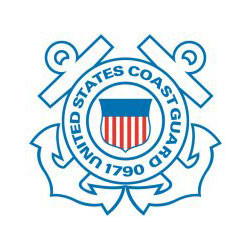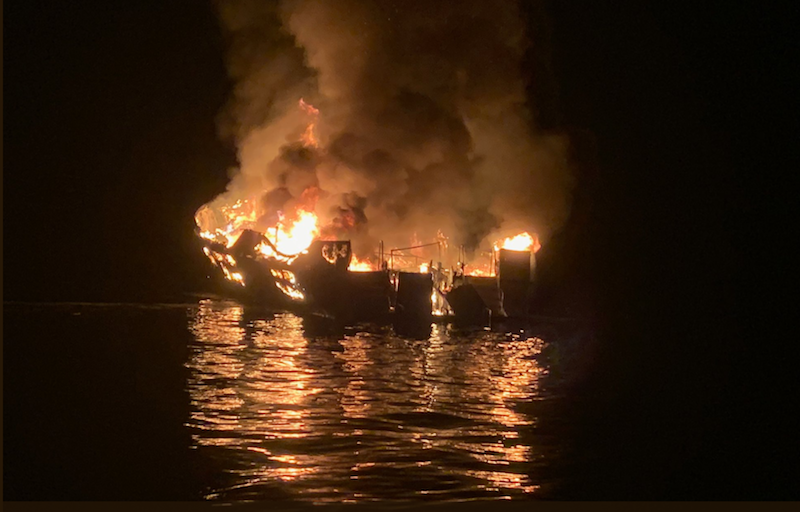The Coast Guard announced yesterday that it has convened a formal Marine Board of Investigation (MBI) to investigate the loss of the small passenger vessel Conception.
Coast Guard assistant commandant for prevention policy, Rear Adm. Richard Timme, made the announcement.
Also, the National Transportation Safety Board released a preliminary report today on the accident involving the commercial diving vessel Conception.
The 75’x25’ wooden hulled Conception caught fire and sank in the early morning hours of Sept. 2, 2019, just off Santa Cruz Island in California. Only five of the 39 people onboard survived.
A commandant-directed formal MBI is the highest-level marine casualty investigation in the Coast Guard. The marine board consists of four members who will investigate all aspects of the casualty including, but not limited to, the pre-accident historical events, the regulatory compliance of the Conception, crewmember duties and qualifications, weather conditions and reporting, safety and firefighting equipment, and Coast Guard oversight.
Separately, the Coast Guard Investigative Service, the Federal Bureau of Investigation, and the Bureau of Alcohol, Tobacco, Firearms and Explosives are supporting a Department of Justice investigation and will work in close coordination with the U.S. Attorney's Office. The Coast Guard MBI will coordinate directly with the DOJ before seeking additional information from a witness, seeking new evidence or holding public hearings.
“The Coast Guard is deeply saddened by the tragedy that occurred near Santa Cruz Island,” said Capt. Jason Neubauer, chair of the Marine Board of Investigation. “Our hearts go out to the victims, as well as their families and friends. The Coast Guard will conduct a thorough and detailed investigation to determine potential causal factors associated with this tragedy.”
During the course of the MBI, panel members must decide:
- The factors that contributed to the accident;
- Whether there is evidence that any act of misconduct, inattention to duty, negligence or willful violation of the law on the part of any licensed or certificated person contributed to the casualty; and
- Whether there is evidence that any Coast Guard personnel or any representative or employee of any other government agency or any other person caused or contributed to the casualty.
A MBI is a lengthy and detailed process that may take a year or longer to complete. It consists of witness interviews, public hearings, and evidence collection and analysis. However, the Coast Guard does not have to wait for the Board’s final report to implement urgent and necessary safety actions.
“In some instances, our marine casualty boards identify pressing safety issues related to vessel stability, the engine room, or lifesaving and firefighting equipment,” said Neubauer. “In those instances, we issue safety alerts or bulletins to ensure a wide spread dissemination of the most recent safety guidance. All of our safety notices and lessons learned from investigations are also publicly available online through the Coast Guard Office of Investigations and Casualty Analysis website.”
The Coast Guard issued just such a safety bulletin Sept. 10, urging mariners to:
- Review the routes and conditions listed on the vessel’s Certificate of Inspection (COI) including the
number of passengers and overnight passengers permitted. Ensure crewmembers are aware of and
clearly understand their obligations including any additional requirements detailed on the COI. - Review emergency duties and responsibilities with the crew and any other crewmember in a safety
sensitive position to ensure they comprehend and can comply with their obligations in an emergency to
include the passenger safety orientation. Ensure emergency escapes are clearly identified, functional,
and remain clear of objects that may impede egress. - Review the vessel log book and ensure records of crew training, emergency drills, and equipment
maintenance are logged and current. Additionally, it is recommended that the master complete log
entries to demonstrate to the Coast Guard that the vessel is operating in compliance with routes and
conditions found on the COI. - Ensure all required firefighting and lifesaving equipment is onboard and operational.
- Reduce potential fire hazards and consider limiting the unsupervised charging of lithium-ion batteries
and extensive use of power strips and extension cords. - Review the overall condition of the passenger accommodation spaces and any other space that is
readily available to passengers during the voyage for unsafe practices or other hazardous arrangements.
The safety bulletin is available online.
An e-mail has been set up for witnesses or anyone else with information about the vessel or the marine casualty. This e-mail will be checked regularly. The e-mail address is: [email protected].




